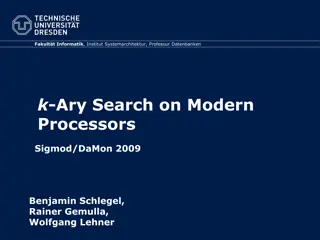When is Enough Enough? Review of Search Strategies by Hannah O. Keefe
Hannah O. Keefe, an Information Specialist from Newcastle, conducts a systematic review on diagnostic test accuracy, comparing traditional search strategies with text mining tools. The results show that the text mining approach yielded more results but decreased precision. Other similar reviews are also discussed, highlighting differences in population, number of index tests, and completion year, while noting that Hannah's study covers all relevant aspects.
Download Presentation

Please find below an Image/Link to download the presentation.
The content on the website is provided AS IS for your information and personal use only. It may not be sold, licensed, or shared on other websites without obtaining consent from the author.If you encounter any issues during the download, it is possible that the publisher has removed the file from their server.
You are allowed to download the files provided on this website for personal or commercial use, subject to the condition that they are used lawfully. All files are the property of their respective owners.
The content on the website is provided AS IS for your information and personal use only. It may not be sold, licensed, or shared on other websites without obtaining consent from the author.
E N D
Presentation Transcript
Search strategies, when is enough enough? Hannah O Keefe Information Specialist From Newcastle. For the world.
When is enough enough? My systematic review Review of diagnostic test accuracy Including all studies with a sequential design Index test conducted before the reference standard 13 index tests Methods Traditional search strategy design (subjective) 11 information sources Evaluation of text-mining tools 16 commonly referenced tools How do they enhance my search strategy? (objective) Comparison to other reviews 6 systematic reviews Search sources Search strategy Included studies 2 From Newcastle. For the world.
When is enough enough? Results Traditional vs text mining approach More results found Decreased precision Search results ~2000 unique results ~450 at full text screening stage ~220 eligible for inclusion Indirect evidence ~160 indirect evidence Right population, index tests, reference standards and outcomes Focussed on performance of the index test as a stand alone not as an alternative for the reference standard Direct evidence ~60 indirect evidence Right population, index tests, reference standards and outcomes Focussed on performance of the index test as an alternative for the reference standard 3 From Newcastle. For the world.
When is enough enough? Other similar reviews Thayyil et al 2010 Broader population Single index test: Pm-MRI 6 included studies* Eriksson et al 2017 Broader population Four index tests: Pm-MRI, Pm-US, Pm-CT & Pm-X-ray 8 included studies* Rossi & Prefumo 2016 Broader population Single index test: Pm-MRI 19 included studies* Shelmerdine et al 2019 Broader population Single index test: Pm-US 4 included studies* Filograna et al 2017 Broader population Single index test: Pm-MRI 8 included studies* Dawood et al 2020 Narrower population Two index tests: Pm-MRI & Pm-CT 39 included studies* * Relevant to my population (not inclusive) 4 From Newcastle. For the world.
When is enough enough? My results vs their results Obvious differences Population Number of index tests Year of completion Inclusion/exclusion criteria But My population covers each of theirs My index tests cover all of theirs My year of completion covers all of theirs All should be picked up for T&A screening Yet... Thayyil = 4/6 Rossi & Prefumo = 12/19 Filograna = 4/8 Eriksson = 7/8 Shelmerdine = 3/4 Dawood = 9/39 5 From Newcastle. For the world.
When is enough enough? Their searches Where did they search? Thayyil = MEDLINE, EMBASE Rossi & Prefumo = PubMed, EMBASE, MEDLINE, ClinicalTrials.gov, Cochrane library Filograna = MEDLINE (PubMed) Eriksson =Cochrane library, HTA, DARE, MEDLINE??, EMBASE?? Shelmerdine = MEDLINE (Ovid), EMBASE (Ovid), Cochrane library Dawood = MEDLINE (ovid), EMBASE (Ovid) How extensive was their strategy? Thayyil = 3 index terms, 2 condition terms Rossi & Prefumo = 5 index terms, 2 population terms, 2 condition terms Filograna = 4 index terms, 5 population/condition terms Eriksson = 39 index terms, 6 condition terms Shelmerdine = 6 index terms, 16 population terms, 5 condition terms Dawood = 22 index terms, 30 population terms, 21 condition terms 6 From Newcastle. For the world.
When is enough enough? What about Dawood? Key points of the search Mix of subject headings and free text Extensively worked up by an Information Specialist Complex search strings of free text Limited from 1995 2019 1831 unique records 232 at full text stage 39 included Any issues? Claimed double negation of animal terms but not evident Only 2 databases No justification for date limit And compared to my search? Roughly the same number of records with more index tests, a broader population, searching more databases, no date limit BUT stricter exclusion criteria 7 From Newcastle. For the world.
When is enough enough? When is enough enough? What if I d been as extensive with my search? How would it have scaled up to include all of my criteria? Would it have given me anything extra? Would my time be worth it? Would the reviewers time be worth it? Would it have made me feel better about my work? What do you think? 8 From Newcastle. For the world.
When is enough enough? Thank you! Questions? Hannah O Keefe nho11@newcastle.ac.uk 9 From Newcastle. For the world.























